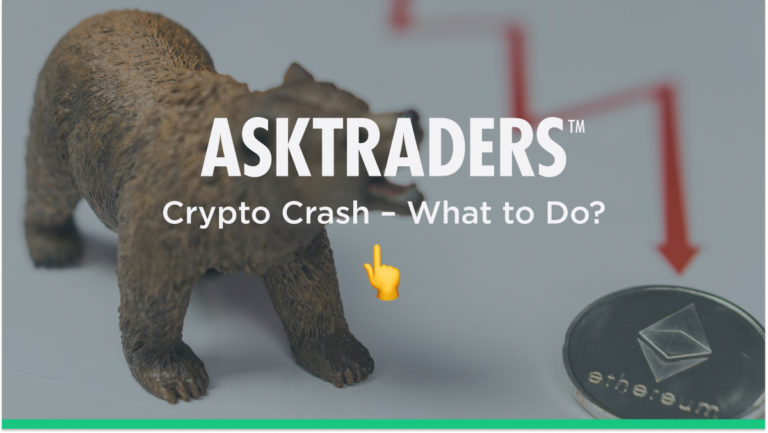
Deciding on how to navigate a crypto price crash depends on your starting position. Are you looking to close out existing positions or put on the new trade of a lifetime? The relative youth of crypto and certain quirks associated with the industry also come into play. Crypto market crashes can feel just like any other market sell-off or like something unique to the sector, but the below analysis will help you find the best route to achieving your investment aims.
Types of Crypto Price Crashes
Every plummeting market attracts investors looking to buy the dip and crypto markets are no different. However, the first step for new entrants who want to optimise their returns is to establish what type of crash is taking place.
Crypto Market Crash – Reduced Risk Appetite
Cryptocurrencies are high-risk assets. Should one of the 18,000 coins believed to be in existence win the race to be the world’s currency, its coins would be valued at levels exponentially higher than they are currently. That race, though, is likely to have only one winner, so about 17,999 run the risk of being near worthless.
The all-or-nothing theme that runs through the crypto sector results in the next big thing attracting significant interest and seeing its price surge. During times when the wider market is buoyant, spare cash can surge into cryptocurrencies as investors posting positive returns from stocks, commodities and bonds hedge against a severe case of FOMO should the crypto revolution materialise.
When market sentiment turns, negative cash can drain from crypto markets as fast as it flooded in. It might be that crypto positions are seen as particularly speculative and liquidating funds on those can support positions in traditional assets. Other traders might use technical analysis to predict whether prices will continue falling and decide that cutting positions early is the best approach.
In this kind of crypto crash, it’s important to remember that the fundamental analysis element of any valuation model has very likely been unchanged. If the underlying prospects of any of the coins remain unchanged, then this type of crypto price crash can represent an opportunity to buy at lower levels.
The crypto price crash of 2017 was a good example of a crypto bubble collapsing in line with the rest of the markets – the main point of note being that the extreme price points in crypto markets massively exceed those of traditional assets.
S&P 500 Index – Daily Price Chart – 2016-2018 – Rise and Fall
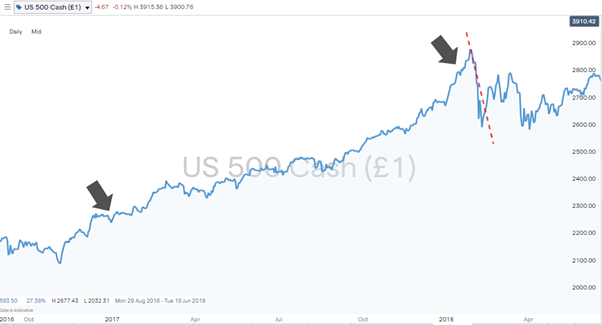
Source: IG
Between December 2016 and December 2017, the S&P 500 index, which is seen as the benchmark of the global equity market, rallied by 17.7% to then in January 2018 slump by 9.8%. Over the same time period, the price of Bitcoin increased by a staggering 1,445% to then give up half of its value and fall by 64.7%.
Bitcoin – Daily Price Chart – 2016-2018 – Rise and Fall
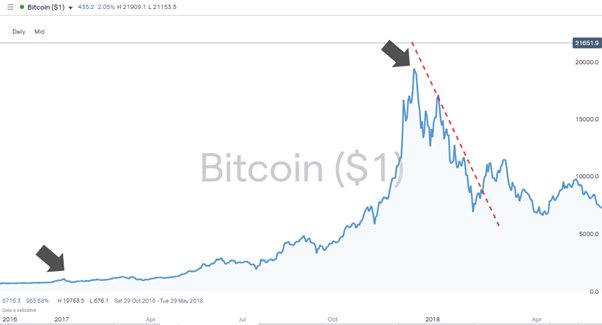
Source: IG
The price of Bitcoin in January 2018 bottomed out in the region of $7,000, which at the time marked an extreme price pullback. Those crypto investors who saw this as being part of the natural ebb and flow of markets and bought BTC at that price were by December 2021 sitting on a percentage gain of more than 500%.
Crypto Market Crash – Isolated Concerns
A price crash in one particular crypto raises a different set of questions. It can be down to investors realising that the technical advantages of a coin have been overplayed, or that a new altcoin offers the same upgrades but in a better way.
In this instance, analysis needs to focus on the long-term prospects of the coin in question, and dip-buying might not be the best course of action.
The implosion in the Terra blockchain in May 2022 is a good example of how a blockchain and the coins operating it can completely collapse. Possibly most concerning is that Terra and its associated coins Luna/UST were billed as ‘stablecoins’. Prior to its 99% price crash, Luna had even ranked in the top 10 of cryptocurrencies by market value.
Over $40bn in value was lost almost overnight when the Luna bubble burst, and while every trend is accompanied by short-term reversals, many consider the game to be up. Vitalik Buterin, founder of Ethereum, was speaking to Forbes about the in-built risks associated with ‘stablecoins’ when he warned that there are many more stablecoins that are “fundamentally flawed” and “doomed to collapse eventually”.
Crypto Market Crash – Paradigm Shift
While cryptocurrencies have become a high-profile asset group, it’s important to remember that the first coin, Bitcoin, was developed less than 15 years ago. In relative terms, the market is still in its infancy, and there are economic events that constitute threats and challenges to their success that just haven’t played out yet.
Bitcoin was founded by Satoshi Nakamoto in 2008 and through the subsequent decade traded in a low-interest-rate, low-inflation environment. Thanks to stimulus measures introduced by governments and central bankers after the Great Recession, cryptocurrencies have yet to experience a significant recession, though this could be about to change.
Some consider Bitcoin and other cryptocurrencies to have the same ‘safe-haven’ characteristics as gold. That would result in them being a good hedge against inflation and the devaluation of fiat currency. The problem for investors in early 2022 was how to factor in the possible positive benefits of higher inflation against the risks of the global economy entering a recession at the same time.
The move from a benign environment to one with numerous variables in play resulted in crypto price volatility picking up. As cryptocurrencies are entering uncharted territory, there is still debate as to whether key metrics such as inflation or unemployment levels will be good or bad for the price. Everyone is entitled to a view, but there is limited historical data to fall back on.
At the same time, those metrics are notoriously difficult to predict. Forecasts for inflation rates in six and 12 months’ time vary from analyst to analyst and uncertainty on that scale results in all assets experiencing a rise in price volatility. Given that cryptocurrencies are highly volatile during more ‘normal’ times, the excessive volatility raises serious questions for crypto investors.
It is, of course, possible to put on a trade that will make a life-changing amount of profit, but the chance of holding onto that position will be improved if basic risk management principles are followed. The events of 2017 highlight how far the crash can go before the trend turns, and trading in small size, and only risking money that you can afford to lose, remain the building blocks of any crypto strategy.
Ethereum – Daily Price Chart – 2020-2022
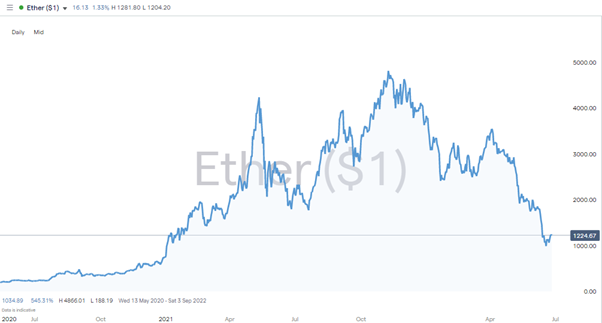
Source: IG
Crypto Market Crash – Operational Risk
Crypto markets are unregulated, meaning that traders get less protection than when trading regulated assets such as stock using a trusted broker. Many die-hard crypto investors are drawn to the anti-establishment approach that blockchain technology provides, but it does mean that concerns about the viability of the crypto ecosystem remain.
Crypto Scams
At one end of the spectrum are those cryptocurrencies set up by scammers with the sole intention of defrauding investors. The Squid Game token, which launched in 2021, piggy-backed off the popular Netflix series of the same name. Those running the platform had no naming rights and built-in protocols, which restricted unsuspecting buyers from selling their coins.
By capturing the zeitgeist associated with the show, the coin’s exploits and meteoric 1,000% price rise in the space of a few days were relayed on mainstream news networks. As with other ‘rug pull’-style schemes, the promoter of Squid Game tokens drew in buyers, removed the ability of holders of coins to trade them, and made off with the money they had raised from sales. Crypto price crashes of these sort can be the most painful for investors, and there is zero incentive to try to pick the bottom of the market.
Crypto Market Crashes and the Role of Regulators
Financial regulators have unsurprisingly taken measures to try to protect the general public from such schemes. Intervention of this kind, or at least the threat of it, can also cause a crypto market crash. Regulators, big banks and governments have a vested interest in keeping the financial markets operating as they are.
In September 2021, China’s central bank declared all cryptocurrency transactions illegal and promised to take action against anyone or any exchange that facilitated them. The warning applied to offshore exchanges as much as crypto miners who operated in the country.
The clampdown on crypto activity in one of the world’s major economies triggered a massive sell-off in cryptocurrencies. Other price drivers played a part, but much of the $2tn loss in value in the crypto markets in 2022 can be traced back to events in China. Regulatory behaviour that shakes confidence in the crypto markets can have a devastating impact on prices, and investors have to take their own view on how justified the new lower valuations are. Will the establishment be able to drive prices to zero, or will the decentralised and in many ways superior functionality of cryptocurrencies win the day?
Crypto Exchanges and Market Crashes
Unique characteristics of the crypto markets can result in the entire structure being questioned, but some crypto market crashes are driven by old-fashioned operational risk concerns. Some brokers offer crypto markets as well as trading in asset groups such as stocks and commodities. Their income stream is diversified, which makes them better equipped to weather a downturn in the crypto markets or a reduction in trading volumes.
Coinbase Global, Inc. – Daily Price Chart – 2021-2022
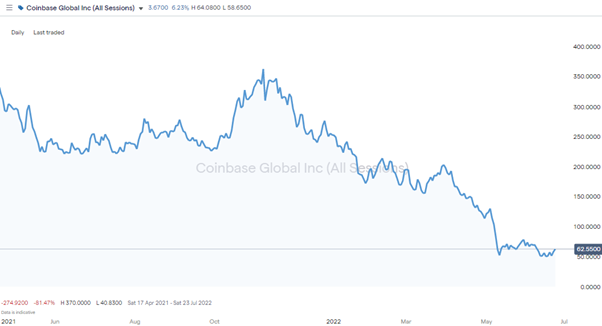
Source: IG
Specialist exchanges that only deal in cryptocurrencies are exposed to the price swings in coins to a similar extent to the holders of the coins. The decision taken in June 2022 by the leading exchange Coinbase to lay off 18% of its global workforce sent shockwaves through the entire sector. The actions of scammers and regulators are harder to predict than the decisions of a listed company such as Coinbase. This could be a sign that crypto markets are in meltdown or could be another case of tech start-ups that ultimately come good overstretching themselves and then having to cut back.
Final Thoughts
The truth is that no one knows whether now is a good time to buy crypto. Every trade in every market is built around risk-return – it’s just that in crypto markets, the price swings can be extreme. Some crypto market price crashes can be considered as part of the cut and thrust of the sector, a chance to buy the dip. Others such as those related to scams, regulators or a platform facing technical obsolescence need to be avoided. There are enough cryptocurrencies in the market with potential to avoid allocating capital to those that appear to be on the way out.
Crypto price crashes triggered by concerns over operational risk fall somewhere in the middle. Systemic risk is never a good thing, but the industry continues to develop and despite its many price crashes, crypto looks set to continue to play some kind of part in the financial system. Focusing on operational risk can help investors in other ways. Some crypto brokers are safer than others, and the brokers on this shortlist of good crypto brokers have been reviewed by the AskTraders team to ensure that they offer appropriate T&Cs to their clients. If buying into a crypto sell-off is something that you’re considering, then choosing one of those platforms for your trade at least manages one of the risks involved.




